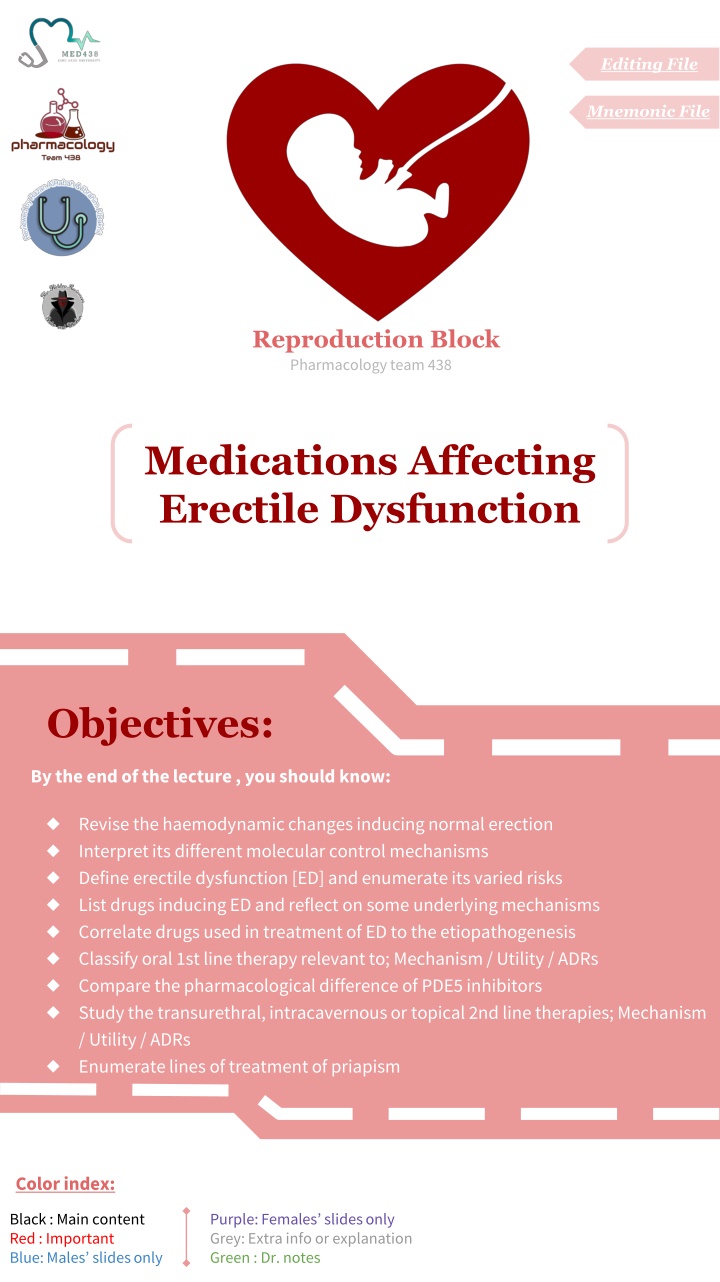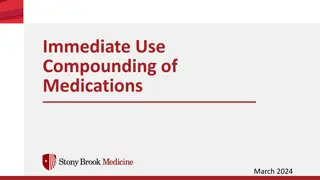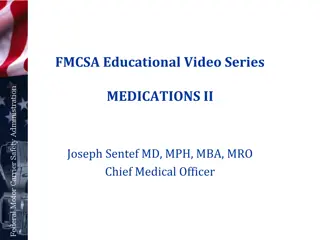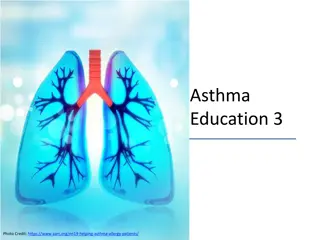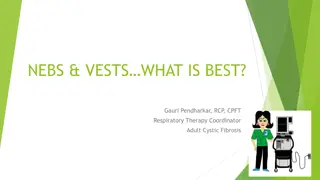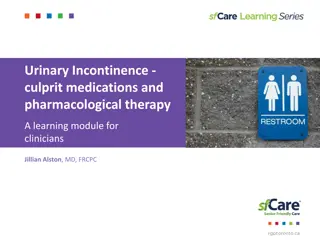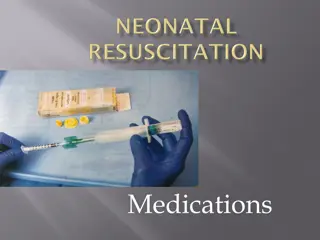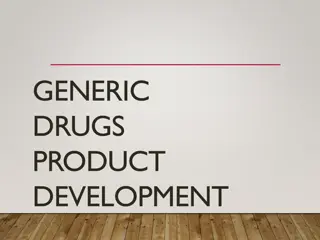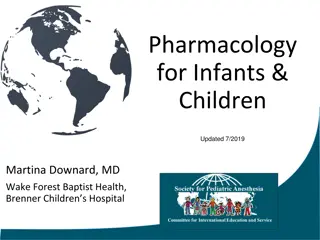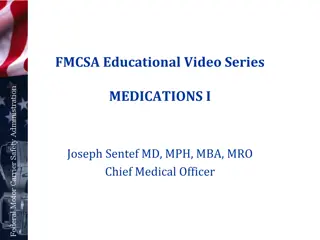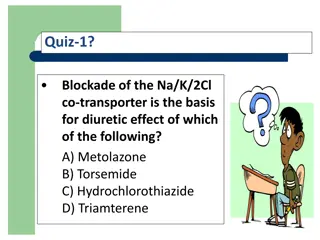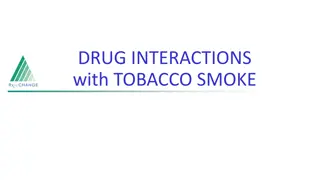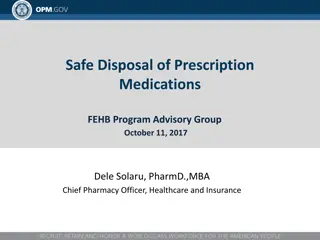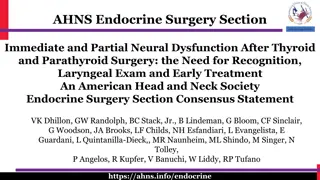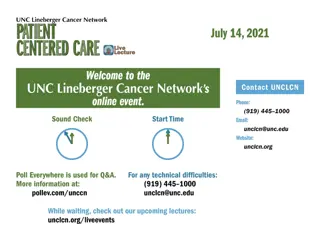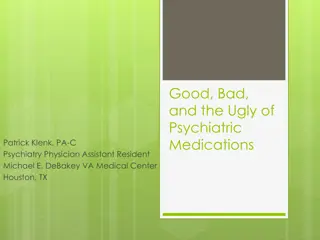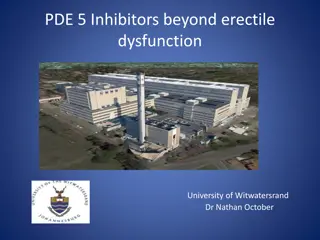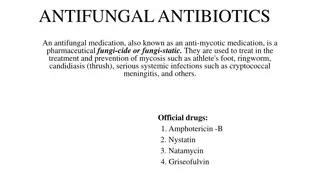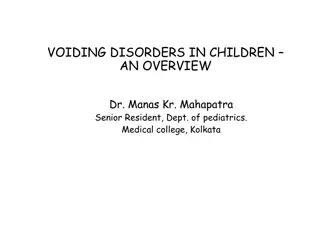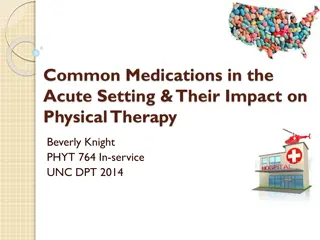Medications for Erectile Dysfunction Overview
This content covers the mechanisms of normal erection, erectile dysfunction, drugs causing ED, treatment options, and classification of therapies for ED. Explore the haemodynamic changes, molecular control, risks, and more related to ED medications.
Download Presentation

Please find below an Image/Link to download the presentation.
The content on the website is provided AS IS for your information and personal use only. It may not be sold, licensed, or shared on other websites without obtaining consent from the author.If you encounter any issues during the download, it is possible that the publisher has removed the file from their server.
You are allowed to download the files provided on this website for personal or commercial use, subject to the condition that they are used lawfully. All files are the property of their respective owners.
The content on the website is provided AS IS for your information and personal use only. It may not be sold, licensed, or shared on other websites without obtaining consent from the author.
E N D
Presentation Transcript
Editing File Editing File Mnemonic File Mnemonic File Reproduction Block Pharmacology team 438 Medications Affecting Erectile Dysfunction Objectives: By the end of the lecture , you should know: Revise the haemodynamic changes inducing normal erection Interpret its different molecular control mechanisms Define erectile dysfunction [ED] and enumerate its varied risks List drugs inducing ED and reflect on some underlying mechanisms Correlate drugs used in treatment of ED to the etiopathogenesis Classify oral 1st line therapy relevant to; Mechanism / Utility / ADRs Compare the pharmacological difference of PDE5 inhibitors Study the transurethral, intracavernous or topical 2nd line therapies; Mechanism / Utility / ADRs Enumerate lines of treatment of priapism Color index: Black : Main content Red : Important Blue: Males slides only Purple: Females slides only Grey: Extra info or explanation Green : Dr. notes
Mechanism of Erection 01 An erection occurs when the amount of blood rushing to the penis is greater than the amount of blood flowing from it1 02 A massive influx of blood accumulates in the sinusoidal spaces due to relaxation of smooth muscle & dilatation of arteries Corpora cavernosa to swell (tumescence/erection) 03 Tumescence compresses the veins that normally drain the penis reduces venous outflow & maintains penile rigidity A normal erection relies on the coordination: Vascular Neurological Hormonal2 Psychological An erection can occur following direct genital stimulation or auditory or visual stimulation aspects that contribute to the influx of blood to the penis 04 Peripheral haemodynamic changes inducing erection (Flaccid) 1 3 2 4 4 Explanation of the picture: Erection is maintain by increased level of of cyclic nucleotides cGMP and cAMP 1. Sexual stimulation -direct, visual ..etc- causes the releasing ofnitric oxidefrom the endothelial cells lining the cavernosal arteries diffuse into the smooth muscle cells of corpora cavernosa 2. Nitric oxide activate guanylyl cyclase system to release cGMPas a second messenger to produce the muscle relaxation action by decreasing the level of Ca+ ; PDE5 degrade cGMP to stop its action 3. PGE1 receptor activated by various stimuli leads to activation of adenylyl cyclase system to release cAMP as a second messenger to help in muscle relaxation 4. Some drugs used in treating ED aim to cGMP as PDE5 inhibitors , or cAMP as Alprostadil 1: due to smooth muscle relaxation. 2: e.g.: thyroid hormone (negatively affect erection)
Erectile Dysfunction ED Complete ED 10% It is a persistent or recurrent inability to attain (acquire)& maintain (sustain) an erection (rigidity) sufficient for satisfactory sexual performance No ED 48% Moderate ED 25% Impotent: is reserved for those men who experience erectile failure during attempted intercourse more than 75 % of the time Minimal ED 17% Prevalence Causes Prof. Yieldez = only know what are highlighted in red Prostatitis, urethritis Inflammatory Mechanical Peyronie's disease , chordee Psychological Depression, performance anxiety, stress, relationship difficulties Arterial: hypertension, smoking, hyperlipidemia, DM, peripheral vascular disease Occlusive Vascular Venous: venous occlusion due to anatomical or degenerative changes Trauma Pelvic fracture, Spinal cord injury, penile trauma Endocrine Hypogonadism, hyperprolactinemia, hypothyroidism, hyperthyroidism Parkinsons, multiple sclerosis, spina bifida, pelvic surgery, peripheral neuropathy Neurologic Anti-hypertension, anti-arrhythmics, antidepressant, anxiolytics, anti-androgens, anticonvulsants, alcohol, marijuana, anti-parkinsonism, LHRH analogues Chemical1 Prostatectomy, old age2, CRF, cirrhosis Extra factors Precursors Outcomes Endothelial dysfunction is the commonest cause Thrombosis Dyslipidemia Erectile dysfunction Tobacco Endothelial cell injury Oxidative stress Diabetes Atherosclerosis Vaso- Hypertension constriction 1:asking about the patient s drug history is extremely important. 2: due to hypogonadism.
Drugs Adversely Causing ED Drug class Examples Beta-blockers Calcium-channel blockers Alpha-adrenergic agonists Cardiac glycosides Propranolol, metoprolol, atenolol Verapamil, nifedipine Clonidine Digoxin Thiazide diuretics Aldosterone antagonists Hydrochlorothiazide Spironolactone Fibric acid derivatives Gemfibrozil , clofibrate SSRI Tricyclic antidepressants Other antidepressants Fluoxetine, sertraline,paroxetine, citalopram Amitriptyline , desipramine, nortriptyline Lithium Benzodiazepines Lorazepam, alprazolam, diazepam Histamine (H2) receptor antagonists Ranitidine, cimetidine Butyrophenones and phenothiazines Haloperidol, prochlorperazine, chlorpromazine Hydantoin anticonvulsant Phenytoin Cytotoxic agents Cyclophosphamide, methotrexate Recreational drugs Alcohol, cocaine, marijuana Mechanisms of How these Drugs Causing ED Central Acting drugs Dopamine1promotes arousal more than epinephrine which have an opposite effect of 5HT (serotonin) on 5HT2 dopamine release arousal anti-Depressant Drugs E.g non-selective (TCAs) selective (SSRIs) anti-depressant drugs 5HT uptake which lead to 5HT in synapse act on 5HT2 dopamine release arousal. SSRI2 have a peripheral effect: antagonize Nitric Oxide actions genital sensation delay ejaculation (use for treatment of premature ejaculation) Anti-psychotic drugs They are DA antagonist, causing hyperprolactinemia They have GABA effect (inhibitory neurotransmitter) antagonize excitatory Amino acid increase sedation arousal. Anti-epileptic drugs E.g phenytoin Anti-Hypertension Methyldopa, Reserpine: arousal Clonidine ( 2 agonist): arousal centrally Central hypotensive 2 blockers: antagonise vasodilating 2 effect + potentiate 1 effect(vasoconstriction) Thiazide diuretics: spinal reflex controlling erection + arousal Other hypotensive 1: hormone of sex and desire. 2: out of all anti-depressants, SSRIs causes erectile dysfunction the most.
Anti-androgen ( They desire1) reductase inhibitor (prevent production of active testosterone) irreversible erectile dysfunction Finasteride2 Cyproterone Acetate3 synthetic steroidal antiandrogen Cimetidine (high doses), ketoconazole, Spironolactone causes hyperprolactinemia + gynecomastia Estrogen-containing medications Other drugs Habituating agents Cigarette smoking cause vasoconstriction + penile venous leakage Smoking Small amount: desire + anxiety + vasodilatation Large amount: sedation + desire Chronic alcoholism: hypogonadism + polyneuropathy Alcohol Drugs Used for the Treatment of ED According to the route of administration Oral: Transurethral: Topical: Intracavernosal: -Selective PDE5 inhibitors4 -Testostero -Apomorphine5 -Oral Phentolamine -Yohimbine -Trazodone -Korean Ginseng -Alprostadil6 -Combinationsof [ Papaverine , Minoxidil, Nitroglycerine, Drug absorption enhancer ] -Alprostadil -Papaverine -Phentolamine7 1) Oral Drugs: Selective PDE5 Inhibitors PDE receptors family and their location Prof. Yieldez = not imp, some effects will be discussed in the next slide know them Receptor Location Receptor Location PDE1 (cGMP) PDE7 (cAMP) Skeletal muscle, heart, kidney, brain, pancreas, T- Lymphocytes Heart,brain,lung,smooth muscle PDE2 (cAMP) Adrenal gland , heart ,lung ,liver, platelets PDE8 (cAMP) Testes, eye, liver, skeletal muscle, heart, kidney, ovary, brain, T-Lymphocyte PDE3 (cAMP) Heart, lung, liver, platelets, adipose tissue, inflammatory cells PDE9 (cGMP) Kidney, liver, lung, brain, possibly heart PDE4 (cAMP) Sertoli cells, kidney, brain, liver, lung, inflammatory cells PDE10 (cAMP) Testes, brain PDE5 (cGMP) Lung, platelets, vascular smooth muscle, heart PDE11 (cGMP) Skeletal muscle, prostate, kidney, liver, pituitary gland, salivary gland, testes PDE6 (cGMP) - Photoreceptor - 1:due to decreased testosterone. 2: used in penile prostate hypertrophy. 3: Used for acne treatment in females. 4: First line therapy. 5: increase sexual desire. 6: prostaglandin analogue. 7: a1 receptor inhibitor.
Sildenafil Vardenafil Tadalafil Avanafil Drugs Inhibit PDE5 prevent breakdown of cGMP pertain vasodilatation erection They do not affect the libido1, so sexual stimulation is essential MOA Pharmacodynamics action relevant to PDE5 inhibition: Vascular smooth muscle cells (VSMCc) of Erectile Tissue of Penis Other VSMCs e.g lung2, brain and heart Other non-VSMCs e.g prostate, bladder, seminal vesicle, GIT Platelets Other tissues; testis, skeletal muscles, liver, kidney, pancreas P.D 1st line therapy in Erectile dysfunction, all types have similarefficacy: Sildenafil: 74-84% Vardenafil: 73-83% Tadalafil: 72-81% Pulmonary hypertension BPH & premature ejaculation Uses 10 folds selective on PDE5&6 16 folds selective on PDE5&6 >200 fold selective on PDE5&6 Selectivity on PDE5 is not absolute and vary with each drug: Can partially act on PDE targeting cGMP (1,5,6,9,11) In higher doses it can act on PDE targeting cAMP (2,3,4,7,8,10) Stimulation of different types can cause ADRs: PDE1&2 Ischemic heart diseases , acute myocardial infarction PDE5&6 Headache, flush, nasal congestion, altered vision PDE11 Back pain Selectivity Fatty food interferes with Sildenafil & Vardenafil absorption, so taken on empty stomach or at least 2 hours after food Tadalafil & Avanafil absorption doesn't affected by food P.K Metabolization: All by hepatic CYT3A4; Tadalafil more than the rest, thus: Increase ADRs with enzyme inhibitors; erythromycin & clarithromycin, ketoconazole, cimetidine, tacrolimus, fluvoxamine, amiodarone...etc. Decrease efficacy with enzyme inducers; rifampicin, carbamazepine, phenytoin Dose 50-100 mg 10-20 mg - Frequency Once a day - Has the advantage of been given 30 min before intercourse Time of adminis -1-12 hours before intercourse 1 hour before intercourse Onset 30-60 min <30-45 min - Duration 4h 4-5h 36h - 1: = not aphrodisiac. 2: therapeutically used in treatment of pulmonary hypertension.
Common ADRs: ADRs Sildenafil Vardenafil Tadalafil 14 10 15 Headache % 12 11 3 Flushing % Congestion Rhinitis Congestion Nasal 7 3 15 Dyspepsia % >4 <2 Specific ADR for Sildenafil Abnormal vision% 5 Specific ADR for Tadalafil Myalgia & back pain% Sperm function Specific ADR for Vardenafil Q-T prolongation Major less common ADRs: Precautions: 1. Ischemic heart diseases & Acute myocardial infarction:patients on large dose or on nitrates1 Hypotension: patients on -blockers than other antihypertensives Bleeding: epistaxis ...etc Priapism: if erection lasts longer than 4 hours emergency situation With blockers (except tamsulosin2) orthostatic hypotension 1. 2. With hepato/renal insufficiency3 2. 3. 4. 1. With bleeding tendencies (leukemia, hemophilia, Vit K deficiency, antiphospholipid syndrome,...etc) Major rare ADRs: 1. Ischemic Optic Neuropathy: can cause sudden loss of vision Sudden Hearing loss 1. Vardenafil: With quinidine, procainamide, amiodarone (class 1 & 3 antiarrhythmic)4 2. C.I: 1. Dose adjustment; when using drugs that have interaction on hepatic liver microsomal enzymes i.e. inhibitors or inducers. 1. 2. 3. Nitrates: total contraindication Hypersensitivity to drug Patients with history of acute MI, stroke, fatal arrhythmias <6 month 1: due to sudden drop in BP. 2: selectively block receptors in the prostate, used in treatment of prostatic hypertrophy. 3: decrease drug clearance = prone to side effects 4: due to QR prolongation induced by vardenafil.
Other Oral Drugs to Treat ED Testosterone (Androgens) Given to those with hypogonadism or hyperprolactinemia. Given for promotion of desirecentrally A dopamine agonist on D2 receptors. Activates arousalcentrally; Erectogenic + Little promotion of desire Given sublingual, so Acts quickly. Not FDA approved, Weaker than PDE5 Given in mild-moderate cases, psychogenic and when PDE5 Is C.I ADRs: nausea, headache, and dizziness but safe with nitrate Apomorphine Oral An 1 blocker, has debatable efficacy Phentolamine Central ( 2 antagonist)and peripheral presynaptic 2 agonist (Aphroditic2+ Erectogenic) but low efficacy and many CV side effects3 Yohimbine1 Trazodone4 Antidepressant, a 5HT reuptake inhibitor (priapism). Korean Ginseng Questionable, may be a Nitric Oxide donner. 2) Topical Drugs to Treat ED -20% Papaverine: increase cAMP + cGMP -Low efficacy and not FDA approval Combinations -2%Minoxidil: NO donner + K channel opener -Female Partner can develop hypotension and headache due to vaginal absorption -2%Nitroglycerine Disadvantages -a drug absorption enhancers 3) Transurethral Drugs to Treat ED Drug Alprostadil MOA Stimulates PGE1 increase cAMP5 Synthetic + more stable Applied by a special applicator into penile urethra & acts on corpora cavernosa which lead to erection Low -Intermediate Efficacy Minimal systemic effects and rarity of drug interactions. P.K Variable penile pain Urethral bleeding, urethral tract infection Vasovagal reflex, Hypotension Priapism or Fibrosis (rare) ADR 1: alkaloid drug. 2: = stimulate desire and sexual drive. 3: e.g. angina pain. 4: causes vasodilation of blood vessels of corpus cavernosa. 5: by activation of adenylate cyclase.
4) Intracavernosal Drugs to Treat ED PGE1 increase cAMP Needs training: Erection after 5-15 min and lasts according to dose injected May develop fear of self injury, so Discontinuation ADRs: Pain or bleeding at injection site Cavernosal fibrosis Priapism Alprostadil PG E1 cAMP + cGMP,It is a direct acting smooth ,muscle relaxant Papaverine1 Phentolamine1 1 blocker 3 combined in severe cases Treatment of Priapism It is a medical emergency Aspirate blood to decrease intracavernous pressure. Intracavernous injection of Phenylephrine (local 1 agonist2) Detumescence 1: promote vasodilation. 2: promote vasoconstriction.
Quiz MCQ Q1- Which of the following is/are contraindications to the use of PDE-5 inhibitors? A- History of a myocardial infarction more than 6 months ago. B-Mild, stable angina. C-Nitrate use. D-All of the above are contraindications to the use of PDE-5 inhibitors. Q2- Sildenafil produces a penile erection by inhibiting what enzyme? A-Cytochrome 3A4 B-cGMP C- Phosphodiesterase D- Adenyl cyclase E- Nitric oxide synthase. Q3- Alprostadil produces an erection by A-increasing tissue levels of GTP. B-increasing tissue levels of cAMP. C-decreasing tissue levels of nitric oxide. D-decreasing tissue levels of cGMP. E-increasing tissue levels of cGMP. Q4- Finasteride causes irreversible erectile dysfunction by blocking: A- - reductase enzyme B- receptors C- androgen receptors D- receptors Q5- The following drugs may be used in erectile dysfunction except? A-Phenylephrine B-Apomorphine C-Alprostadil D-PGE1 analogues (Papaverine) SAQ - 66-years-old man complained of difficulty maintaining an erection. He is concerned about the use of drugs to restore sexual function, particularly about the need to time therapy with anticipated sexual activity. Q1-What is the drug of choice that is indicated for this patient because of its long duration of action? Q2-What is the M.O.A of that drug? - 42-years-old patient who is taking a PDE-5 inhibitors for treating ED, later he is diagnosed with angina and be treated with Nitroglycerin. Q3-Which drug would be the safest to be used with Nitroglycerin in this patient to treat erectile dysfunction? Q4-Mention 2 ADR of that drug. - 44-years-old male came to ER with Priapism persist for 6 hours, What is the drug of choice that is indicated in this case ? MCQ SAQ Q1 C Q1 Tadalafil Q2 C Q2 Inhibit PDE5 prevent breakdown of cGMP pertain vasodilatation erection Answers: Q3 B Q3 Apomorphine Q4 A Q4 nausea, headache, and dizziness Q5 A Q5 Intracavernous injection of Phenylephrine
Thank you for all the love and support you gave the team in those two years! Hope we made the context much easier to study. God bless you, Future doctors. Team Leaders: May Babaeer Zyad Aldosari This Amazing Work was Done By: Rema AlMutawa Ghalia AlNufaei Note writers Raghad AlKhashan Quiz writers Noura AlMazrou Shahad AlSahil
